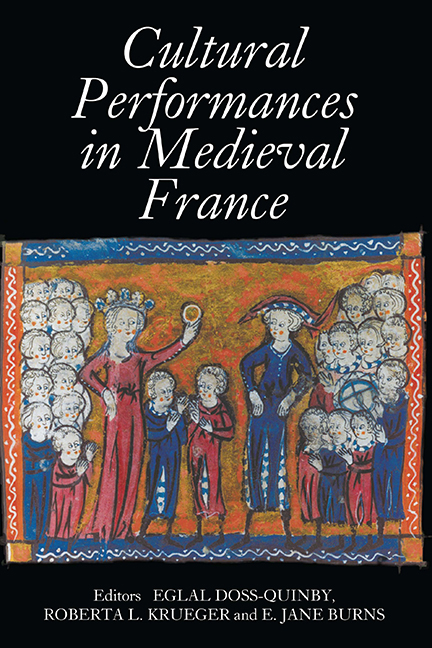Book contents
- Frontmatter
- Contents
- List of Illustrations
- Contributors
- Introduction
- Nancy Freeman Regalado, Curriculum Vitae
- PART I POETIC AND MUSICAL PERFORMANCES
- PART II PERFORMING SEXUAL AND SOCIAL IDENTITIES
- PART III DEVOTIONAL PRACTICE AND TEXTUAL PERFORMANCE
- PART IV PERSUASIVE PERFORMANCES
- PART V RE–ENACTMENTS AND LEGACIES
- Variegated Performance of Aucassin et Nicolette
- Late Medieval Representations of Storytelling and Story-Performance
- Paratextual Performances in the Early Parisian Book Trade: Antoine Vérard's Edition of Boccaccio's Nobles et cleres dames (1493)
- “Resuscitating” Medieval Literature in New York and Paris: La femme que Nostre-Dame garda d'estre arse at Yvette Guilbert's School of Theatre, 1919–24
- The Pitfalls and Promise of Classroom Performance
- ” Dunc chante haut et cler » : remarques sur l'interprétation de la musique médiévale
- Tabula Gratulatoria
- Tabula Gratulatoria
Late Medieval Representations of Storytelling and Story-Performance
from PART V - RE–ENACTMENTS AND LEGACIES
Published online by Cambridge University Press: 24 October 2017
- Frontmatter
- Contents
- List of Illustrations
- Contributors
- Introduction
- Nancy Freeman Regalado, Curriculum Vitae
- PART I POETIC AND MUSICAL PERFORMANCES
- PART II PERFORMING SEXUAL AND SOCIAL IDENTITIES
- PART III DEVOTIONAL PRACTICE AND TEXTUAL PERFORMANCE
- PART IV PERSUASIVE PERFORMANCES
- PART V RE–ENACTMENTS AND LEGACIES
- Variegated Performance of Aucassin et Nicolette
- Late Medieval Representations of Storytelling and Story-Performance
- Paratextual Performances in the Early Parisian Book Trade: Antoine Vérard's Edition of Boccaccio's Nobles et cleres dames (1493)
- “Resuscitating” Medieval Literature in New York and Paris: La femme que Nostre-Dame garda d'estre arse at Yvette Guilbert's School of Theatre, 1919–24
- The Pitfalls and Promise of Classroom Performance
- ” Dunc chante haut et cler » : remarques sur l'interprétation de la musique médiévale
- Tabula Gratulatoria
- Tabula Gratulatoria
Summary
The decision to re-enact on the page a scene of oral storytelling is extraordinarily prevalent in late-medieval French literature, as it will continue to be throughout the sixteenth century. Texts such as the anonymous Cent nouvelles nouvelles (1462) and the anonymous Évangiles des quenouilles (ca. 1470–80) experiment with the staging of oral storytelling in a range of ways, using embedded narratives, the structural device of the frame, and the depiction of storytelling circles. Scenes of oral storytelling are fertile ground for inquiry regarding late medieval practices of story transmission, especially the dynamic relation between performance and audience reception.
This essay proposes to examine how storytelling and story-performance are represented in the narrative literature of late-fifteenth-century France, and why the staging of these processes was so compelling for authors of the period. Indeed, why did late-medieval narrative artists choose not merely to tell stories, but also to show others telling stories, and to contain within their romans and collections of nouvelles reflections upon the art and function of storytelling? What can we posit as the motivation for such complex narrative structurings?
It perhaps goes without saying that the storytelling conventions highlighted in these collections call repeated and insistent attention to the presence of the cercle conteur, begging the question of whether the point of such collections is precisely to illustrate the dynamics of any interpretive community, the reactions of the story recipients, and the necessity of their presence. That is, the authors of these collections elected not merely to tell stories, but rather to show stories in the process of being told and received. Indeed, the meaning of such story collections may lie not only in the stories themselves, or in the reactions of members of the cercle conteur inscribed in the tales, but also in the author's examination of how this crucial transaction takes place.
These texts can (and, I suggest, should) be read as symbolic story performances: the reader-reception circuit – the act of reception and interpretation – is dramatized before our eyes through the evocation of the sound of the human voice. Most theorists of reader-reception have not paid sufficient attention to the medieval or early modern periods, taking as their primary examples contemporary models of textual transmission and reading in which interpretation is a solitary act accomplished in silence and/or in writing.
- Type
- Chapter
- Information
- Cultural Performances in Medieval FranceEssays in Honor of Nancy Freeman Regalado, pp. 247 - 254Publisher: Boydell & BrewerPrint publication year: 2007



